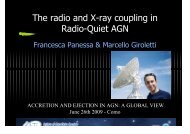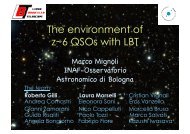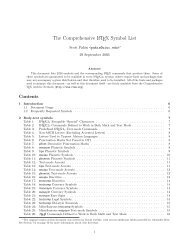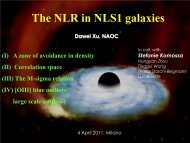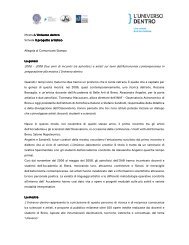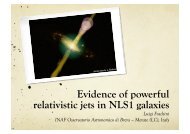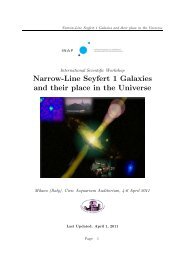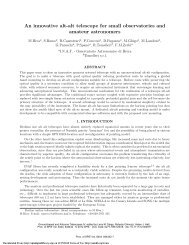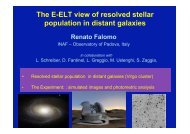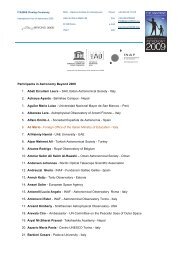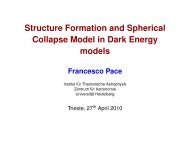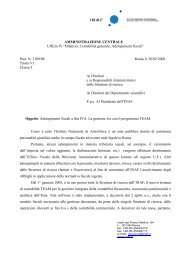IASFRome_StatusReport - INAF-IASF-Roma
IASFRome_StatusReport - INAF-IASF-Roma
IASFRome_StatusReport - INAF-IASF-Roma
Create successful ePaper yourself
Turn your PDF publications into a flip-book with our unique Google optimized e-Paper software.
<strong>IASF</strong> <strong>Roma</strong> - STATUS REPORTfor the Visiting CommitteeRef: <strong>IASF</strong>-RM-VC-001/07DATA: 19 November 2007Page: 7/134Executive Summary1 Structure and organization of the Research StructureThe Istituto di Astrofisica Spaziale e Fisica Cosmica (hereafter Space Astrophysics Institute) of<strong>Roma</strong>, was founded at the beginning of the 60es under the lead of Prof. Livio Gratton. TheInstitute has a long tradition in the field of stellar and planetary evolution and nuclearastrophysics, with a strong experiemental vocation basically due to its initial cultural andtopological contiguity to the Istituto Nazionale di Fisica Nucleare (the Italian Nuclear PhysicsInstitute INFN) and the National Committee for Nuclear Enery (CNEN), all of them locatedcloseby the Frascati village.In the ‘60es a young group of theoreticians, observers and experimentalists was moulded byLivio Gratton as the 4th Astrophysical Research Group within the University of Rome, mainlyworking on star theory and stellar evolution. A few years late the group became large enoughand so active in different fields (Radio Pulsar and X-Ray sources were just discovered) to gainindependence and moved in the Frascati area as the Space Astrophysics Laboratory (LAS).This young batch of enthusias scientists started to develop complex and sophisticated stellarevolution models taking into advantage the newly born computer machines. At the same time,the high energy experimentalists, initially working on the new X and Gamma ray astrophysicsscience focussed on the design and realisation of high energy experiments that were flown onboard sounding rockets and stratospheric balloons in collaboration with NASA and CNES. Inthe 70es the planetary science underwent a strong acceleration due to the USA Moonprogramme with the extraordinary opportunity to study “in corpore vili” rocks samples returnedto Earth by the Apollo programme, and to participate to design, build calibration and launch ofthe first planetary probes.At the beginning of the 80es our Institute was one of the major promoter with a key role in theideation design and realisation of the first scientific Italian satellite: BeppoSAX.Scientific Activity: basic factsThe short above historical record is important to remind the cultural origin of the Laboratorio diAstrofisica Spaziale that in the timeframe of more than 40 years have provided an essentiallifeblood to several generations of scientists and technicians and have generated the actual fivemain streams of the <strong>IASF</strong> science programmes:1) Solar System Research2) Stars, Stellar Population and Interstellar Medium3) Relativistic Astrophysics: X and Gamma Ray4) “Curiosity Driven” Research5) Research and Development: Advanced Technologies and Instrumentations1.1 Solar System ResearchIn recent years the Solar System has been intensively explored, up to its innermost andoutermost regions, and since the end of the past decade the formation of our own planetarysystem has been considered in the light of the knowledge coming from the observations of7



